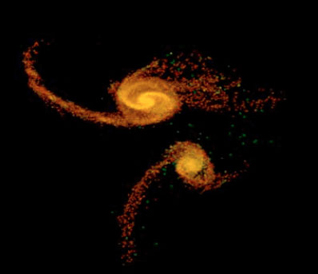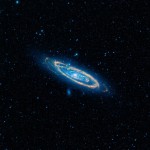Was the Andromeda Galaxy, the largest and most massive galaxy in our local neighborhood, shaped into its current structure due to a monstrous collision over 6 billion years ago? According to a new study by some French astronomers, the answer is oui.
They created a lovely animation based on the model. It shows the collision of the two galaxies and how they interact:
Wow! You can see how the galaxies get disrupted, and perhaps get something of a feel for just how violent and incredible an event on this scale can be.
Using a sophisticated computer code that models the gravitational and fluid (pedantic: hydrodynamical) interaction between stars, gas, dust, and dark matter, they found that an ancient and massive collision between a galaxy a bit bigger than our Milky Way, and a smaller one about 1/3 the mass, reproduces a large amount of the structure we see in Andromeda today. That includes “…the large thin disk including its giant ring of gas and dust, the massive central bulge, the gigantic thick disk, the giant stream of old stars, as well as many other stellar streams discovered in the galaxy halo” according to the press release (the paper itself is in French).
 Not only that, but it may solve another big mystery: what the heck are the Magellanic Clouds? These are two small, irregular galaxies that apparently orbit the Milky Way; they are the closest galaxies to us at a distance of about 180,000 light years each. Recent studies have hinted that these galaxies may not actually be orbiting us as always thought, but might be passing us by at nearly a million kilometers per hour. This new model of Andromeda shows that during the collision, a long streamer of gas would’ve been drawn out and ejected. This is called a tidal tail, and is common in large collisions. In this case, the model indicates the tail may have formed the two Magellanic galaxies and sent them heading our way!
Not only that, but it may solve another big mystery: what the heck are the Magellanic Clouds? These are two small, irregular galaxies that apparently orbit the Milky Way; they are the closest galaxies to us at a distance of about 180,000 light years each. Recent studies have hinted that these galaxies may not actually be orbiting us as always thought, but might be passing us by at nearly a million kilometers per hour. This new model of Andromeda shows that during the collision, a long streamer of gas would’ve been drawn out and ejected. This is called a tidal tail, and is common in large collisions. In this case, the model indicates the tail may have formed the two Magellanic galaxies and sent them heading our way!
The most basic aspect of a good scientific model is that it should solve some issue you see. For example, why does the Andromeda galaxy have a ring of gas circling its center? If your model explains that, then great! But if it also explains lots of other structures, then that means the model has a much better chance of being right, or at least being mostly right. This new model seems to do just that.
 So this new study is pretty cool. We know that there have been lots of little collisions over the eons; we think all big galaxies like the Milky Way and Andromeda built up to their current size by eating and absorbing smaller galaxies. But those are usually dinky dwarf galaxies; this new study may show that Andromeda also had at least one really, really big collision long ago.
So this new study is pretty cool. We know that there have been lots of little collisions over the eons; we think all big galaxies like the Milky Way and Andromeda built up to their current size by eating and absorbing smaller galaxies. But those are usually dinky dwarf galaxies; this new study may show that Andromeda also had at least one really, really big collision long ago.
And regular readers know as well that there’s another one coming: in a billion years or two, the Milky Way and Andromeda may themselves collide. Both galaxies are among the largest in the near Universe, so when this happens it’ll be a spectacular and amazing event. I wonder if alien astronomers hundreds of million of light years away, and billions of years hence, will get images of the ensuing merger and gasp (assuming they breathe) in awe as I do when I see such a magnificent tableau?
Image and video credit: GEPI, Observatoire de Paris / NAOC
Related posts:
- Spiraling tentacles of galactic doom
- A Swift view of Andromeda
- The first spectacular views of the sky from WISE!
- Awesome Antennae!